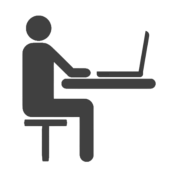


Rightsizing
is
about
looking
at
the
efficiency
of
your
office
space
and
your
new
relationship with workplaces (remote and HQ).
It’s
about
identifying
ways
to
scale
and
optimise
the
operating
cost
of
your
spaces
and form a workplace strategy.
We do this by adopting an approach to three formats for spaces:
1) Lease Space
- Looking at your existing lease arrangements:
•
Identifying your NEW relationship with spaces.
•
Outsourcing office functions including remote strategies for meeting
rooms, collaborative areas (special projects) and WFH / location hubs
(Hub & Spoke).
•
Space planning and recalibrating your lease agreements (including a
review of net internal rented areas).
2) Flexible
- Switching to Flexible Spaces with remote strategies.
3) Hybrid
- A combination of leasing and Flexible arrangements. Scaling both
options and striking the right balance to meet your business model.
Rightsizing
We use a Desk Rate for comparing costs between leasing and flexible spaces.
The
desk
rate
is
an
important
metric
and
is
arguably
more
relevant
than
traditional
methods
of
comparing
costs
and
spaces.
A
rate
per
square
foot
only
relates
cost
for
space
.
It
doesn’t
tell
you
if
that
space
is
the
right
fit
for
your
business
and
if
you
don’t
know
if
the
space
is
right,
how
can
you
tell
if
you’re
getting
the
best
value
for
your
space
?
A ‘load’ rate per desk goes further by relating
cost to use and function
.
The
distinction
is
an
important
one
if
you
want
to
know
how
relevant
your
space
will
be
and
how
much
it
will
benefit
your
business.
You
need
to
know
how
to
cost
the
space
in
order to make informed decisions about how much space you really need.
Flexible spaces are ideal because they scale to your business and not the other way round.
Moreover,
a
lease
rate
per
square
foot
based
on
net
rent
will
not
include
the
business
rates
and
running
costs
for
that
space.
The
rent
may
only
be
40%
of
the
total
cost
for
your
space with the remaining costs being less obvious to the untrained eye.
The
Desk
Rate
is
the
best
metric
for
determining
value
for space and use, for the following reasons:
1) It is an inclusive cost.
2) It indicates the efficiency of the space.
3) It offers a powerful comparison for alternative
options when space planning or considering flexible
spaces.
The
desk
rate
that
we
use
for
leasing
represents
more
than
the
immediate
space
around
the
workstation.
It
represents
all
of
the
spaces
that
comprise
and
serve
the
office
environment.
We
call
this
the
‘area
load’
and
we
express
this
as
a
desk
rate
to
reflect
the
value
of
the
entire
office
space
and
its
efficiency.
These
‘load’
areas
include
receptions,
meeting
rooms,
lounges,
circulation
zones,
and
amenity
spaces.
The
area
load
will
vary
between
businesses
and
will
depend
on
your
business
model
and
how you use your space.
Because
a
desk
rate
relates
cost
to
use,
the
focus
is
to
optimise
the
office
space
to
deliver
efficiency
and
value.
It
also
ensures
that
letting
fees
are
driven
DOWN
by
efficiency
and
value
rather
than
driven
UP
by
the
size
of
the
office
or
deal
!
This
means
a
service
driven
approach
to
agency
and
a
better
outcome
for the customer.
Our
Rightsizing
Service
is
based
on
our
analysis
and
appraisal
system,
which
has
been
carefully
calibrated
to
provide
a
more
rigorous
and
cost
driven
assessment.
This
helps
our
customers achieve the best value for the right space.

This
is
the
ratio
between
a
full
time
office
worker
and
the
office
space.
Traditional
Leasing
involves
a
quoting
rent
per
square
foot
(psf).
However,
the
rent
only
represents ~ 40% of the total cost to the occupier.
A
rate
psf
is
great
if
you’re
fitting
a
carpet
but
it
doesn’t
really
tell
you
how
efficient
or
appropriate the space is for your business model.
This
is
why
we
use
a
method
based
on
a
desk
rate
and
area
load
.
We
use
this
method
for
tailoring
the
space
and
estimating
ALL
COSTS
rather
than
relying
on
just rent per square foot.
We
call
our
method
Rightsizing
.
An
explanation
of
this
approach
and
its
benefits
can
be demonstrated.







OFFICE Solve


Rightsizing
is
about
looking
at
the
efficiency
of
your
office
space
and
your
new
relationship
with
workplaces (remote and HQ).
It’s
about
identifying
ways
to
scale
and
optimise
the
operating
cost
of
your
spaces
and
form
a
workplace strategy.
We
do
this
by
adopting
an
approach
to
three
formats
for
spaces:
1)
Lease
Space
-
Looking
at
your
existing
lease
arrangements:
•
Identifying your NEW
relationship with spaces.
•
Outsourcing office functions
including remote strategies for
meeting rooms, collaborative
areas (special projects) and
WFH / location hubs (Hub &
Spoke).
•
Space planning and
recalibrating your lease
agreements (including a
review of net internal rented
areas).
2)
Flexible
-
Switching
to
Flexible
Spaces
with
remote
strategies.
3)
Hybrid
-
A
combination
of
leasing
and
Flexible
arrangements.
Scaling
both
options
and
striking
the
right
balance
to
meet
your
business
model.
Rightsizing
We
use
a
Desk
Rate
for
comparing
costs
between
leasing and flexible spaces.
The
desk
rate
is
an
important
metric
and
is
arguably
more
relevant
than
traditional
methods
of
comparing
costs
and
spaces.
A
rate
per
square
foot
only
relates
cost
for
space
.
It
doesn’t
tell
you
if
that
space
is
the
right
fit
for
your
business
and
if
you
don’t
know
if
the
space
is
right,
how
can
you
tell
if
you’re
getting
the
best
value
for
your
space
?
A
‘load’
rate
per
desk
goes
further
by
relating
cost to use and function
.
The
distinction
is
an
important
one
if
you
want
to
know
how
relevant
your
space
will
be
and
how
much
it
will
benefit
your
business.
You
need
to
know
how
to
cost
the
space
in
order
to
make
informed
decisions
about
how much space you really need.
Flexible
spaces
are
ideal
because
they
scale
to
your
business
and
not
the other way round.
Moreover,
a
lease
rate
per
square
foot
based
on
net
rent
will
not
include
the
business
rates
and
running
costs
for
that
space.
The
rent
may
only
be
40%
of
the
total
cost
for
your
space
with
the
remaining
costs
being
less
obvious
to
the
untrained
eye.
The
Desk
Rate
is
the
best
metric
for
determining
value
for
space
and
use,
for the following reasons:
1) It is an inclusive cost.
2) It indicates the efficiency of the
space.
3) It offers a powerful comparison
for alternative options when space
planning or considering flexible
spaces.
The
desk
rate
that
we
use
for
leasing
represents
more
than
the
immediate
space
around
the
workstation.
It
represents
all
of
the
spaces
that
comprise
and
serve
the
office
environment.
We
call
this
the
‘area
load’
and
we
express
this
as
a
desk
rate
to
reflect
the
value
of
the
entire
office
space
and
its
efficiency.
These
‘load’
areas
include
receptions,
meeting
rooms,
lounges,
circulation
zones,
and
amenity
spaces.
The
area
load
will
vary
between
businesses
and
will
depend
on
your
business
model and how you use your space.
Because
a
desk
rate
relates
cost
to
use,
the
focus
is
to
optimise
the
office
space
to
deliver
efficiency
and
value.
It
also
ensures
that
letting
fees
are
driven
DOWN
by
efficiency
and
value
rather
than
driven
UP
by
the
size
of
the
office
or
deal
!
This
means
a
service
driven
approach
to
agency
and
a
better
outcome for the customer.
Our
Rightsizing
Service
is
based
on
our
analysis
and
appraisal
system,
which
has
been
carefully
calibrated
to
provide
a
more
rigorous
and
cost
driven
assessment.
This
helps
our
customers
achieve
the
best
value
for
the right space.

This
is
the
ratio
between
a
full
time
office
worker
and
the
office
space.
Traditional
Leasing
involves
a
quoting
rent
per
square
foot
(psf).
However,
the
rent
only
represents
~
40%
of
the
total
cost
to
the
occupier.
A
rate
psf
is
great
if
you’re
fitting
a
carpet
but
it
doesn’t
really
tell
you
how
efficient
or
appropriate
the
space is for your business model.
This
is
why
we
use
a
method
based
on
a
desk
rate
and
area
load
.
We
use
this
method
for
tailoring
the
space
and
estimating
ALL
COSTS
rather
than
relying
on
just
rent
per
square foot.
We
call
our
method
Rightsizing
.
An
explanation
of
this
approach
and
its
benefits
can
be
demonstrated.








OFFICE Solve
































